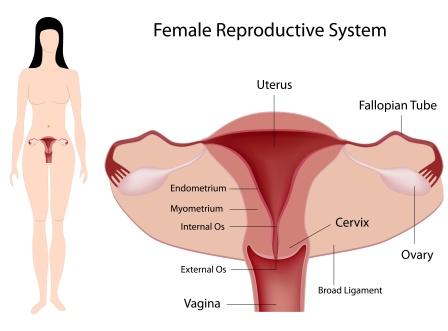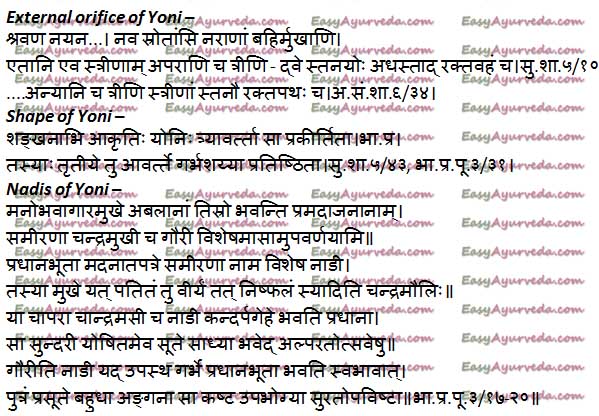Anatomy Of Female Reproductive System – Ayurvedic Perspective
By Dr Raghuram Y.S. MD (Ay) & Dr Manasa, B.A.M.S
Female reproductive system, as explained by Ayurveda, comprises of below mentioned components and almost resemble explanation given in modern anatomy.
Table of Contents
Introduction
Parts of female reproductive system are –
– Bhaga – vulva
– Smarata patra or Bhaga Shishnika – clitoris
– Yoni – vagina
– Garbhashaya – uterus
Read – Anna Visha – When Food Turns Toxic: Causes, Symptoms

Bhaga – Vulva
Dimension-
According to Sushruta, bhaga measures 12 angulas vistara. 1 angula is approximately equal to 1.89 cm (0.75 inch) This makes 22.68 cm (9 inches) approximately.
Dalhana, commentator of Sushruta Samhita opines that bhaga is nothing but yoni i.e. the measurement of vaginal introitus of women.
According to him, meaning of vistara is opening which leads into vaginal canal.
Dimension i.e. 12 angulas mentioned by Sushruta is measurement of vaginal introitus of women called hastini mentioned in kamashastra or sexology.
This means that ordinary women do not have introitus of this dimension. This also could mean that this is maximum dimension of vaginal introitus (vulva).
The 12 angula measurement also seems to be description of circumference of entire vulva instead of introitus of vagina.
Read – Menstrual Pain, Painful Periods – Natural Ayurvedic Herbal Home Remedies
Shape of Bhaga –
Dalhana has mentioned that shape of vulva resembles leaf of banyan tree.
Smaratapatra / Bhagashishnika – clitoris.
Dalhana has explained about smaratapatra.
Location of Smaratapatra according to Dalhana –
Situated in upper portion of vulva resembling the leaf of banyan tree i.e.
Below to this clitoris one can find yoni bahirmukha i.e. orifice for discharge of menstrual blood or external opening. This is highly stimulated during sexual act. The other names of Smaratapatra are smaramandira and madanaatapatra.
Read – Ashayapakarsha By Vata: Displacement of Pitta, Kapha Dosha
Yoni – vagina
Term also covers entire female reproductive system.
It is one of bahirmukha srotas i.e. one of external orifices in women which excretes menstrual blood every month.
It is situated below clitoris.
Read – Pitta Associated With Ama – Symptoms And Treatment
Shape of yoni- resembles shankhanabhi i.e. hollow portion of interior of conch shell.
It has 3 avartas i.e. circles within it. Uterus is attached to its third or innermost avarta.
According to Bhavaprakasha treatise, there are three kinds of nerve tissue in vaginal canal of females.
They are Samirana, Chandramukhi and Gauri Nadi.
Garbhashaya
Garbhashaya means uterus
Garbha = fetus
Ashaya = residence
Read – Ashaya – Meaning, Types, Location, Utility
Garbhashaya = place where fetus stays during nine months of its development and maturity.
Garbhashaya is one among the ashayas. It is 8th ashaya and is found only in women.
Other names of Garbhashaya –
– Garbha shayya
– Dhara (Bhavaprakasha)
– Dimba (Vagbhata, Arunadatta)
Location of Garbhashaya –
Garbhashaya is located in between small intestine and large intestine in 3rd avarta or circle of vagina.
According to Sushruta and Vagbhata, uterus is also located behind urinary bladder.
According to Kashyapa, uterus is located amidst the coils of intestine and is covered by jarayu i.e. peritoneum.
Shape of Garbhashaya –
Garbhashaya resembles shape of rohita matsya mukha i.e. mouth of rohita fish.
Read – Asthi Shareera – Definition, Anatomy, Types Of Bones
Other Anatomical structures related to Garbhashaya
Garbhashaya forms one of roots of channels responsible for carrying and expelling menstrual blood.
Garbhashaya is related with 2 arteries responsible for formation of menstrual blood / ovum and two arteries for excretion of menstrual blood.
Garbhashaya is closely related to guda marma i.e. ano rectal region and vasti marma – urinary bladder. Injury to these vital organs may also include injury to uterus and vice versa.
Read – Koshta – Large anatomical Body Cavities
There are 10 muscles related to female reproductive system, mainly uterus.
– 1 outer circular muscle (sphincter vaginae)
– 2 muscles spreading inside vaginal canal or introitus (anterior and posterior vaginal walls)
– 3 muscles in garbha chidra or uterine cavity (fundus, corpus and isthmus of uterus)
– 3 muscles for entry of sperms and ovum (1 cervix for entry of sperms, 2 fallopian tubes for entry of ovum)
Anatomy of vagina
Anatomy of vagina as per Ayurveda:
According to Ayurveda, Yoni means vagina. Word yoni according to Ayurvedic treatises refers to entire reproductive system and also to individual organs separately.
Yoni rachana – structure and anatomy of vagina
External orifice of Yoni –
Females are said to have three extra external orifices in addition to 9 external orifices present in man. This makes a total of 12 external orifices in female.
Among three extra orifices, two are present in breasts i.e. one in each breast and other orifice is located downwards to excrete menstrual blood. This external orifice which is meant to excrete menstrual blood every month is situated below clitoris.
Read –Hypomenorrhoea: Causes, Remedies, Ayurvedic Treatment
Sanskrit sloka

Shape of Yoni
Shape of yoni resembles hollow portion of conch shell in shape.
It has three avartas i.e. circles. The uterus is attached in third avarta.
Shape of yoni resembles mid part of conch shell as it is narrow at introitus and very wide at fornices.
Dr Joshi compares three avartas of yoni as –
– Vagina with its adnexal structures
– Cervix with adnexa
– Uterus with adnexa
Dr Ghanekar explains that avartas of yoni are folds of mucous membrane of vagina.
Read – Interrelationship Of Pelvic Organs As Explained By Sushruta
Other explanations of three avartas of yoni –
Opinion 1 –
– Introitus
– Mid canal
– Fornices
Opinion 2 –
– External genitalia
– Vagina
– Uterus adnexa
Read – Polycystic ovarian syndrome: Ayurvedic Treatment, Remedies, Diet
Opinion 3 –
– Submeatal sulcus
– Transverse vaginal sulcus
– Bladder sulcus
Opinion 4 –
This seems to be logical explanation to three avartas of yoni because Dalhana and Indu have accepted uterus as separate entity from these three avartas and these avartas are said to be situated in vaginal canal.
Three avartas of yoni can be compared to –
– Outer circle – thick connective and fibrous layer separating vaginal canal from urinary bladder and urethra anteriorly and from rectum posteriorly.
– Middle circle – muscular coat of vaginal canal.
– Inner layer – mucous membrane of vaginal canal.
Read –Essential Elements For Conception – Garbha Sambhava Samagri
Nadis of Yoni –
According to reference in Bhavaprakasha treatise, there are three kinds of nerves / tissues in Manobhavaagaara mukha i.e. vaginal canal of females.
– Samirana nadi
– Chandramukhi nadi
– Gauri nadi
Read – Gulma- Abdominal Tumor- A Unique Disease In Ayurveda
Samirana Nadi – Samirana is located mainly at the madanaatapatra or clitoris.
Semen falling over it becomes futile. It is wasted and will not be helpful in fertilizing ovum.
Chandramasi Nadi – Woman having chandramasi nadi in kandarpageha or mid-vaginal canal is easily satisfied with coitus. Such a woman, after getting conceived would deliver female children.
Gauri Nadi – Woman having gauri nadi in upasthagarbha i.e. deep vaginal canal is satisfied with difficulty in terms of sexual satisfaction. Such a woman, after getting conceived would deliver usually male children.
Consult Dr Raghuram Y.S. MD (Ayu) – Email / Skype







